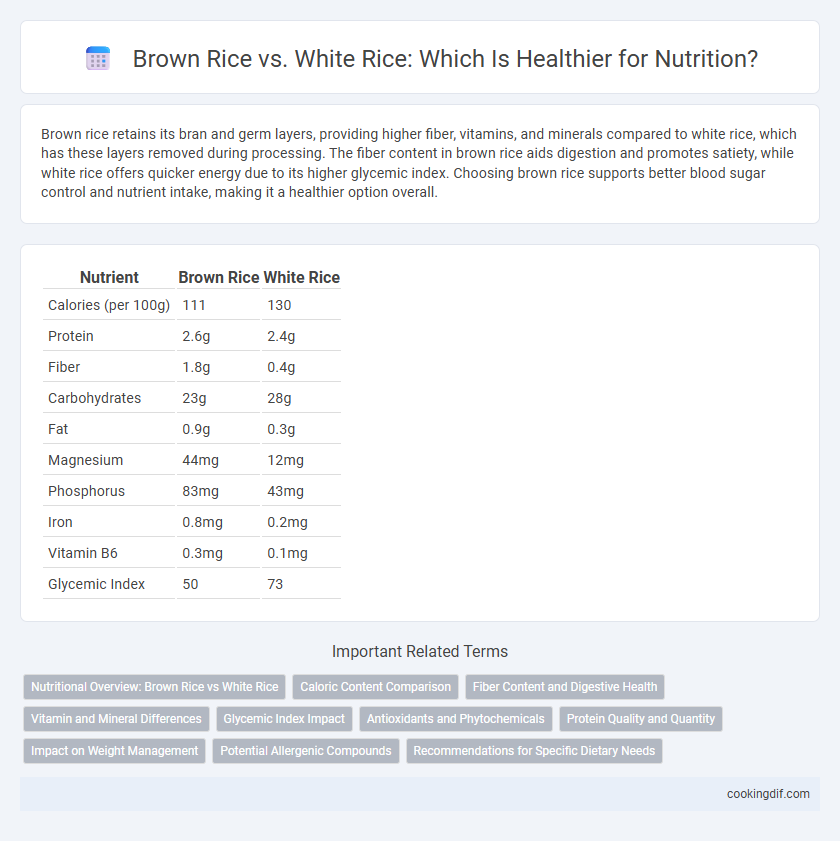Brown rice retains its bran and germ layers, providing higher fiber, vitamins, and minerals compared to white rice, which has these layers removed during processing. The fiber content in brown rice aids digestion and promotes satiety, while white rice offers quicker energy due to its higher glycemic index. Choosing brown rice supports better blood sugar control and nutrient intake, making it a healthier option overall.
Table of Comparison
| Nutrient | Brown Rice | White Rice |
|---|---|---|
| Calories (per 100g) | 111 | 130 |
| Protein | 2.6g | 2.4g |
| Fiber | 1.8g | 0.4g |
| Carbohydrates | 23g | 28g |
| Fat | 0.9g | 0.3g |
| Magnesium | 44mg | 12mg |
| Phosphorus | 83mg | 43mg |
| Iron | 0.8mg | 0.2mg |
| Vitamin B6 | 0.3mg | 0.1mg |
| Glycemic Index | 50 | 73 |
Nutritional Overview: Brown Rice vs White Rice
Brown rice contains higher levels of fiber, magnesium, and antioxidants compared to white rice, due to the retention of the bran and germ layers during processing. White rice undergoes milling and polishing, which removes these nutrient-rich components, resulting in lower fiber and micronutrient content but a longer shelf life. Brown rice typically has a lower glycemic index, making it a better option for blood sugar regulation and overall metabolic health.
Caloric Content Comparison
Brown rice contains approximately 215 calories per cooked cup, slightly higher than white rice's 205 calories per cooked cup due to its intact bran and germ layers. This higher caloric content in brown rice is accompanied by increased fiber, vitamins, and minerals, contributing to a slower digestion rate and sustained energy release. White rice offers fewer calories but lacks the complete nutrient profile found in brown rice, making brown rice a more nutrient-dense choice for energy and satiety.
Fiber Content and Digestive Health
Brown rice contains significantly higher dietary fiber than white rice, with about 3.5 grams per cooked cup compared to 0.6 grams in white rice, which enhances digestive health by promoting regular bowel movements and reducing constipation. The bran and germ layers retained in brown rice contribute essential nutrients and antioxidants that support gut microbiota balance. Consuming brown rice can lead to improved satiety and better blood sugar regulation due to its higher fiber content, making it a superior choice for digestive wellness.
Vitamin and Mineral Differences
Brown rice contains higher levels of vitamins and minerals compared to white rice due to its intact bran and germ layers. It is rich in magnesium, phosphorus, selenium, B vitamins such as thiamine and niacin, and vitamin E, which are significantly reduced during the milling process that produces white rice. White rice primarily offers energy in the form of carbohydrates but lacks the broader spectrum of micronutrients found in brown rice.
Glycemic Index Impact
Brown rice has a lower glycemic index (GI) compared to white rice, typically ranging from 50 to 55 versus white rice's 70 to 89, resulting in a slower blood sugar response. The higher fiber content in brown rice slows carbohydrate absorption, which helps regulate postprandial glucose levels and reduces insulin spikes. Choosing brown rice can support better glycemic control, especially beneficial for individuals managing diabetes or metabolic syndrome.
Antioxidants and Phytochemicals
Brown rice contains higher levels of antioxidants and phytochemicals compared to white rice, primarily due to the intact bran and germ layers that are removed during the milling process of white rice. These compounds, including phenolic acids, flavonoids, and lignans, contribute to neutralizing free radicals and reducing oxidative stress in the body. Regular consumption of brown rice is associated with enhanced antioxidant capacity and potential protective effects against chronic diseases linked to oxidative damage.
Protein Quality and Quantity
Brown rice contains higher protein levels than white rice, providing approximately 7.5 grams of protein per cooked cup compared to white rice's 4.3 grams. The protein in brown rice maintains more essential amino acids, including lysine and methionine, resulting in superior protein quality. White rice undergoes polishing that removes bran and germ, which lowers both protein quantity and the availability of key amino acids crucial for muscle repair and growth.
Impact on Weight Management
Brown rice contains higher fiber and essential nutrients like magnesium compared to white rice, promoting better satiety and digestion. The increased fiber content in brown rice helps regulate blood sugar levels and supports steady energy release, which can aid in weight management. White rice, being more processed, has a higher glycemic index, potentially leading to quicker spikes in blood sugar and increased hunger, making it less ideal for weight control.
Potential Allergenic Compounds
Brown rice contains higher levels of potential allergenic compounds such as phytic acid and certain proteins compared to white rice, which can trigger allergic reactions in sensitive individuals. The bran layer in brown rice, retained during processing, contributes to these allergenic compounds, whereas white rice is milled and polished, reducing their presence. Despite this, brown rice offers more fiber and nutrients but may pose a higher allergenic risk for individuals prone to rice allergies.
Recommendations for Specific Dietary Needs
Brown rice offers higher fiber, magnesium, and antioxidants compared to white rice, making it suitable for individuals aiming to improve digestion, manage blood sugar, or increase nutrient intake. White rice, being lower in fiber and easier to digest, is often recommended for people with sensitive digestive systems or those needing quick energy replenishment. For diabetic patients, brown rice's lower glycemic index supports better blood glucose control, while athletes may benefit from white rice's rapid carbohydrate availability.
Brown vs White for nutrition Infographic

 cookingdif.com
cookingdif.com